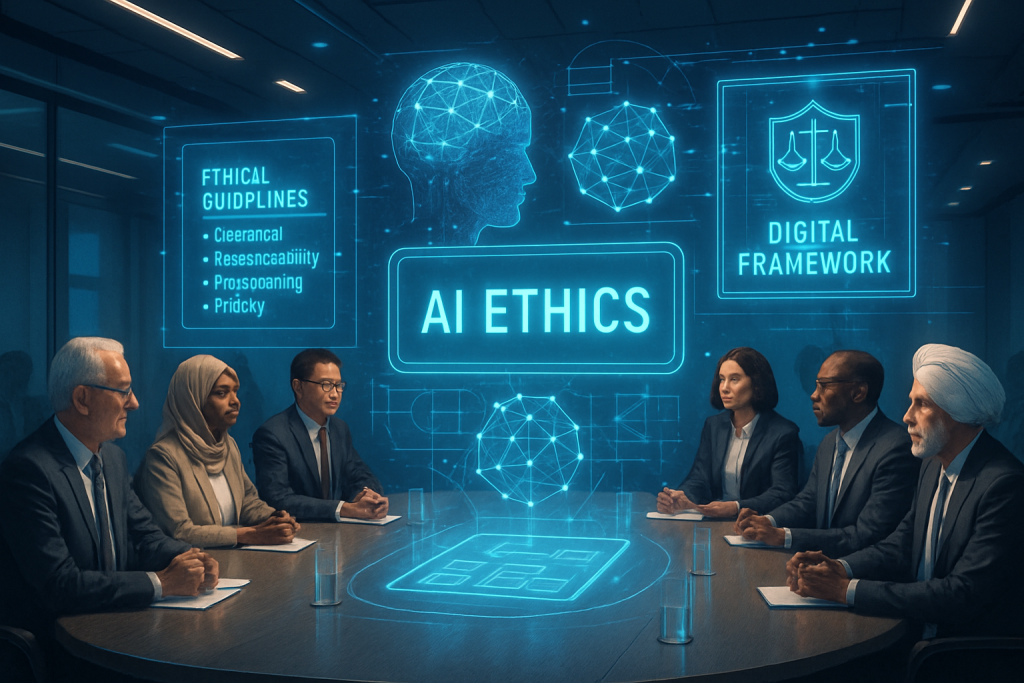The year is 2025. Flying cars, still stubbornly absent from our driveways, remain a futuristic fantasy. But something far more profound than personal air transport is taking flight: the global governance of artificial intelligence. Last week, the International Telecommunication Union (ITU) wrapped up its AI for Good Global Summit in Geneva, and the echoes of the event are still reverberating through the tech world. Think of it as the AI equivalent of the Yalta Conference, but instead of redrawing national borders, they’re drawing lines of code, ethical boundaries, and global standards for a technology that’s rapidly reshaping our reality.
The summit, which drew over 10,000 participants both in person and virtually, wasn’t just a talk-shop. It was a crucial step towards a more unified and responsible approach to AI development. It’s a bit like the Wild West of AI is finally starting to get some sheriffs and some rules.
So, what exactly went down in Geneva that has everyone buzzing? Let’s break it down.
First and foremost, the ITU, working hand-in-glove with the International Organization for Standardization (ISO) and the International Electrotechnical Commission (IEC), unveiled a Unified AI Standards Framework. Yes, that’s a mouthful, but its implications are huge. Imagine trying to build a global internet without common protocols like TCP/IP. Chaos, right? That’s where we were heading with AI. Different countries, different companies, all developing AI with their own standards, or worse, no standards at all. This framework is designed to be the TCP/IP of AI, providing a common language and set of guidelines for development and deployment across the globe. A key focus is on AI watermarking and deepfake detection, crucial in an era where truth can be algorithmically manufactured.
Why is this so important? Think about the implications for elections. Imagine a hyper-realistic deepfake of a presidential candidate making inflammatory statements just days before an election. Without clear standards for detecting and verifying AI-generated content, we’re essentially handing the keys to the kingdom over to disinformation campaigns. The framework aims to establish clear guidelines to help authenticate AI content and fight deepfakes. It won’t be a silver bullet, but it’s a vital first step.
Then there’s the AI for Good Impact Initiative. This initiative is all about scaling AI solutions to tackle some of the world’s most pressing problems. We’re talking climate change, poverty, healthcare, education – the big stuff. The initiative includes competitions, accelerators, and policy guidance, all designed to foster innovation and ensure that AI benefits everyone, not just the tech elite. It’s like a tech-powered Marshall Plan for the 21st century, aiming to spread the benefits of AI across the globe.
But it wasn’t all just policy and frameworks. The summit also showcased some truly mind-blowing AI innovations. We’re talking next-generation generative AI that can create stunning works of art and mind-controlled robotic prosthetics that could revolutionize the lives of amputees. These demos weren’t just tech demos; they were glimpses into a future where AI is seamlessly integrated into our lives, helping us to create, heal, and connect in ways we never thought possible. Imagine controlling a prosthetic arm with the power of your thoughts, painting masterpieces with AI-powered tools, or using AI to diagnose diseases with unprecedented accuracy. That’s the promise of AI for Good.
Of course, all this progress comes with its own set of challenges. The summit also addressed the ethical considerations surrounding AI development. How do we ensure that AI systems are fair, transparent, and accountable? How do we prevent AI from perpetuating existing biases or creating new forms of discrimination? These are not easy questions, and there are no easy answers. But the fact that these questions are being asked, and that the global community is coming together to address them, is a sign of progress. It’s like the tech world is finally having its “Frankenstein moment” and realizing that with great power comes great responsibility.
So, who are the big winners and losers here? It’s hard to say definitively at this stage. The immediate winners are likely to be companies and researchers who are already working on responsible and ethical AI development. The framework and the Impact Initiative will provide them with a much-needed boost, both in terms of funding and recognition. The long-term winners will be all of us, if we can successfully navigate the ethical and societal challenges of AI and harness its power for good.
The companies that might feel some pressure are those who have been prioritizing speed and innovation over ethics and transparency. They’ll need to adapt to the new regulatory landscape and demonstrate that their AI systems are aligned with global standards. It’s a bit like the auto industry facing emissions regulations. It may be initially costly, but ultimately it leads to better and more sustainable products.
From a financial perspective, the summit could unlock significant investment in AI for Good initiatives. Governments, philanthropists, and venture capitalists are all likely to be drawn to projects that align with the UN’s Sustainable Development Goals. We could see a surge in funding for AI-powered solutions in areas like healthcare, education, and environmental protection.
But the biggest takeaway from the AI for Good Global Summit is this: the future of AI is not predetermined. It’s up to us to shape it. By working together, across borders and disciplines, we can ensure that AI is a force for good in the world. It won’t be easy, but the stakes are too high to sit on the sidelines. The future is being written, line by line, algorithm by algorithm, and it’s our responsibility to make sure that it’s a story worth telling. It’s time to boldly go where no algorithm has gone before, but with a compass firmly set on ethical and responsible development.
Discover more from Just Buzz
Subscribe to get the latest posts sent to your email.


